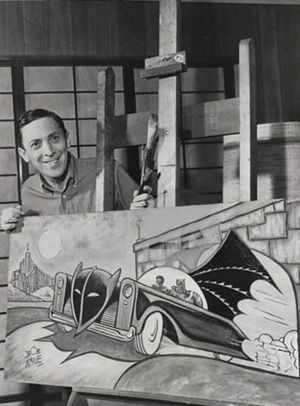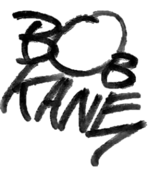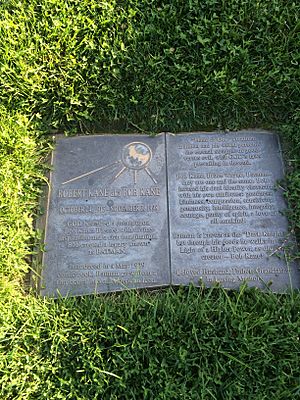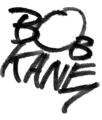Bob Kane facts for kids
Quick facts for kids Bob Kane |
|
|---|---|

Kane posing with a Batmobile painting in 1966
|
|
| Born | Robert Kahn October 24, 1915 New York City, U.S. |
| Died | November 3, 1998 (aged 83) Los Angeles, California, U.S. |
| Nationality | American |
| Area(s) | Writer, Penciller |
|
Notable works
|
Detective Comics |
| Spouse(s) |
Beverly
(died 1957)Elizabeth Sanders
(m. 1987) |
| Children | 1 daughter |
| Signature | |
 |
|
Robert Kane (born Robert Kahn; October 24, 1915 – November 3, 1998) was an American comic book artist and writer. He is best known for co-creating the famous superhero Batman with Bill Finger. He also helped create many other early characters for DC Comics.
Bob Kane was honored for his work in the comic book world. He was added to the Jack Kirby Hall of Fame in 1993. Later, in 1996, he joined the Will Eisner Comic Book Hall of Fame. These are big honors in the comic book industry.
Contents
Early Life and First Jobs
Robert Kahn was born in New York City, New York. His parents were Augusta and Herman Kahn. His father worked as an engraver, making designs on metal.
When he was in high school, Robert was friends with Will Eisner. Will later became a famous cartoonist too, known for creating The Spirit. After high school, Robert Kahn officially changed his name to Robert Kane. He then studied art at Cooper Union. In 1934, he started working as a trainee animator at Max Fleischer's studio.
Starting in Comics
Bob Kane began working in the comic book field in 1936. He drew and wrote stories for a magazine called Wow, What a Magazine!. One of his first works was a series called Hiram Hick.
The next year, Kane started working at a studio called Eisner & Iger. This studio was one of the first to create comics for publishers. Publishers were new to the world of mass media in the late 1930s and 1940s. This time is known as the Golden Age of Comic Books.
At Eisner & Iger, Kane worked on a feature called "Peter Pupp." This story was about talking animals. He also created humor comics like "Ginger Snap" and "Oscar the Gumshoe." For Adventure Comics, he drew his first adventure strip, "Rusty and his Pals."
Creating Batman
In early 1939, DC Comics had a huge hit with Superman. This made other comic editors want more superheroes. So, Bob Kane came up with the idea for "the Bat-Man."
Kane said he got ideas from a few places. He was inspired by the actor Douglas Fairbanks playing Zorro in movies. He also looked at Leonardo da Vinci's drawings of a flying machine with bat-like wings. Another idea came from the 1930 movie The Bat Whispers.
Bill Finger joined Bob Kane's studio in 1938. Finger was a writer who met Kane at a party. Kane offered him a job helping to write his comic strips.
Finger said he made many suggestions for Batman's look. He suggested a cowl and a cape that looked like bat wings. He also thought of adding gloves and making the mask's eyeholes blank to add mystery. Finger also suggested changing the costume's bright red parts to gray and black. He said his ideas were also inspired by Lee Falk's comic strip character, The Phantom.
Finger also said he came up with Batman's secret identity, Bruce Wayne. He wrote the very first Batman story, and Kane drew the pictures. Bob Kane had already shown his idea for Batman to DC Comics. He also had a contract, so he was the only one officially credited for creating Batman. However, many people agree that Bill Finger played a very important role.
According to Kane, "Bill Finger was a contributing force on Batman right from the beginning. He wrote most of the great stories."
Batman first appeared in Detective Comics #27 in May 1939. He quickly became very popular. Within a year, Kane hired art helpers like Jerry Robinson and George Roussos. These artists helped with inking and drawing backgrounds. Kane did most of his own drawing at home.
Later, DC Comics wanted more Batman stories than Kane's studio could make. So, the company assigned other artists to help. These artists drew under Kane's guidance but were not given credit. They were called "ghost artists."
In 1943, Kane stopped drawing the main Batman comic books. He focused on drawing the daily Batman newspaper comic strip. Other artists at DC Comics then drew the comic book stories. After the newspaper strip ended in 1946, Kane returned to the comic books. He continued to use "ghost artists" to help him.
Introducing Robin
Kane had created a sidekick for an earlier character, Peter Pupp. He thought about adding a boy sidekick for Batman named Mercury. This boy would have worn a "super-costume."
However, Jerry Robinson suggested a normal human boy instead. Robinson also came up with the name "Robin." He got the idea from Robin Hood books he read as a child.
The new character was an orphaned circus performer named Dick Grayson. He came to live with Bruce Wayne as his young ward. Robin first appeared in Detective Comics #38 in April 1940. This character inspired many other sidekicks in comic books during that time.
The Joker
Batman's main enemy, the Joker, was introduced around the same time. He first appeared in Batman #1 in Spring 1940. There is some discussion about who exactly created the Joker.
Jerry Robinson said that Bill Finger wrote the script for the Joker's first story. He added that Bob Kane and he worked on how the Joker looked. So, all three played a part in creating this famous villain.
Other Characters
Bob Kane also helped create many other well-known Batman villains.
- The villain Two-Face is widely believed to be Kane's idea alone.
- Catwoman, first called "the Cat," was partly inspired by Kane's cousin, Ruth Steel. Kane also said that actress Jean Harlow was a model for her design. He felt that women were often like cats.
- Kane created the Scarecrow and drew his first appearance. Bill Finger wrote the story for it.
- Kane also created the first version of Clayface.
- According to Kane, he drew the Penguin after seeing a penguin mascot for Kool cigarettes. This mascot had a top hat and a cane. However, Bill Finger said he created the Penguin as a funny version of a fancy, old-fashioned gentleman.
Later Life and Career
In 1966, Bob Kane stopped working for DC Comics. He decided to focus on fine art instead. As his comic book work slowed down, he became a minor celebrity because of Batman.
He also worked in television animation. He created characters like Courageous Cat and Cool McCool. Kane also showed his paintings in art galleries.
In 1985, DC Comics honored Kane in their 50th-anniversary book, Fifty Who Made DC Great. Kane wrote an autobiography called Batman and Me in 1989. An updated version came out in 1996.
Kane worked as an advisor for the 1989 movie Batman. He also advised on its three sequels.
Personal Life
Bob Kane married his first wife, Beverly, in the 1940s. They divorced in 1957 and had one daughter, Deborah. In 1987, Kane married his second wife, actress Elizabeth Sanders Kane.
Bob Kane passed away on November 3, 1998, in Los Angeles. He was 83 years old. He is buried at Forest Lawn Memorial Park in the Hollywood Hills of Los Angeles, California.
Awards and Honors
Bob Kane received the Inkpot Award in 1977. He was inducted into the Jack Kirby Hall of Fame in 1994. In 1996, he joined the Will Eisner Comic Book Hall of Fame. He was also added to the National Comics Awards' Roll of Honour in 1999.
On October 21, 2015, Bob Kane received a star on the Hollywood Walk of Fame. This was for his work in movies. His star is located at 6764 Hollywood Boulevard.
Kane's artwork is kept in important collections. These include the Museum of Modern Art and the Whitney Museum of American Art in New York City. His work is also at St. John's University.
Images for kids
See also
 In Spanish: Bob Kane para niños
In Spanish: Bob Kane para niños




